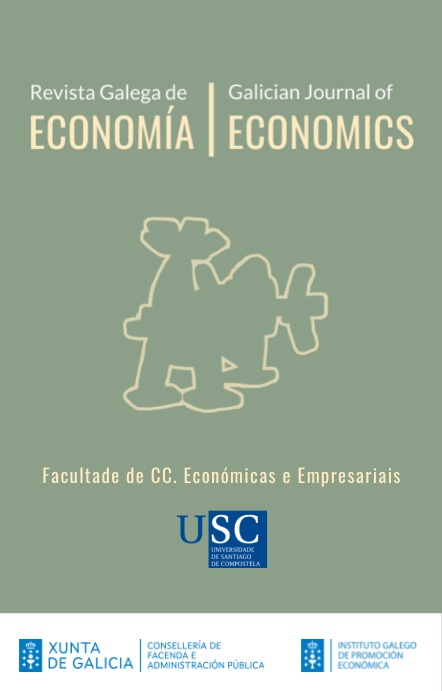Quantitative impacts of basic income grant on income distribution in Cote d’Ivoire: Time to change our societies
Contido principal do artigo
Resumo
Palabras chave
Detalles do artigo
Citas
Aka, B.F. 2006. Poverty, Inequality and Welfare Effects of Trade Liberalisation: A CGE model for Côte d’Ivoire. AERC Research Paper No. 160. African Economic Research Consortium, Nairobi.
Aka, B.F. (2007 a). “Relative Effects of Public And Private Investment On Côte D’Ivoire’s Economic Performance”, Applied Econometrics and International Development, Vol. 7-1.
Aka, B.F. (2007 b). “The Saving-Investment Relationships: A Markov Switching Causality Analysis of Côte d´Ivoire and Ghana”, Applied Econometrics and International Development, Vol. 7-2.
Aka, B.F. (2008). “Revisiting the Export-Output Nexus for Western Africa Countries: A Markov Switching Causality Approach”, Applied Econometrics and International Development, Vol. 8.1.
Aka, B.F and S. Diallo (2011) “Influence of the Fiscal System on Income Distribution in Regions and Small Areas: Microsimulated CGE Model for Côte d’Ivoire”. AERC Research Paper 218, African Economic Research Consortium, Nairobi, January.
Armington, P.S. 1969. "A Theory of Demand for Products Distinguished by Place of Production". IMF Staff Paper No. 16: 15976.
Atkinson, A.B. 1987. “On the measurement of poverty”. Econometrica, 55(4): 74964. Bresson, Y. 2014. “Le Revenu d’Existence. L’urgence de son instauration”, Lettre de liaison 80 – AIRE, Printemps 2014.
Chernick, H. and A. Reschovsky, 1990. “The taxation of the poor”. Journal of Human Resources, 25: 71235.
Clark, S., R. Hemming and D. Ulph. 1981. “On indices for measurement of poverty”. Economic Journal, 91(362): 51526.
Cockburn, J. 2001. “Trade liberalization and poverty in Nepal: A micro simulation analysis”. CREFA, Université Laval, Canada.
Decaluwé, B., A. Patry, L. Savard and E. Thorbecke. 1999. Poverty Analysis within a General Equilibrium framework. Cahier de Recherche 9906, Centre de Recherche en Economie et Finance Appliquée (CREFA), Université Laval, Canada.
Decaluwé, B., A. Martens and L. Savard. 2001. La Politique économique du développement et les modèles d’équilibre général calculable. Les presses universitaires de Montréal, Canada.
Foster, J., J. Greer and E. Thorbecke. 1984. “A class of decomposable poverty measures”.
Guisan, M.C. (2014). “World Development, 2000-2010: Production, Investment and Savings In 21 Areas of America, Africa, Asia-Pacific, Europe and Eurasia”, Regional and Sectoral Economic Studies, Vol. 14-2.
Guisan, M.C., Exposito, P. (2002). “Education, Industry, Trade and Development of African Countries in 1980-99”, Applied Econometrics and International Development,Vol. 2-2.
Guisan, M.C., Exposito, P. (2005). “Human Capital and Economic Development in Africa: An Econometric Analysis for 1950-2002”, Applied Econometrics and International Development, Vol. 5-1.
Guisan, M.C., Exposito, P. (2007). “Education, Development and Health Expenditure in Africa: A crosssection model of 39 countries in 2000-2005”, Applied Econometrics and International Development, Vol. 7-2.
Hanemann, W.M. 1991. “Willingness to pay and willingness to accept: How much can they differ”? American Economic Review, 81(3): 63547.
Hicks, J. 1939. “Value and Capital”. Oxford, UK: Clarendon Press.
Randall, A. and J.R. Stoll. 1980. “Consumer’s surplus in commodity space”. American Economic Review, 71(3): 44957, June.
Ravallion, M. 1996. “Comparaison de la pauvreté”. LSMS document de travail No. 122. Banque mondiale.
Ravallion, M. and B. Bidani. 1994. “How robust is a poverty profile?” World Bank Economic Review, 8: 75102.
Samson, M., Babson, O., Haarman, C. Haarman, D., Khathi, G., Mac Quene, K. and van Niekerk, I. (2002) ‘Research Review on Social Security and the Basic Income Grant for South Africa.’ Report for the International Labor Organization compiled by the Economic Policy Research Institute, Cape Town, South Africa.
Sen, A.K. 1976. “Poverty: An ordinal approach to measurement”. Econometrica, 44(2): 21931.
Sen, A.K. 1981. “Poverty and Famines: An Essay on Entitlement and Deprivation”. Oxford: Clarendon Press.
Sen, A.K. 1985. “A sociological approach to the measurement of poverty: Reply to Professor Townsend”. Oxford Economic Paper No. 37: 66976.
Sen, A.K. 1987. “The Standard of Living”. Cambridge: Cambridge University Press.
Sen, A.K. 1997. “On Economic Inequality”. Oxford: Clarendon Press.
Taylor,V. (ed.) (2002) ‘Transforming the Present – Protecting the Future.’ Report prepared for the Department of Social Development by the Committee of Inquiry into a Comprehensive System of Social Security for South Africa. Pretoria, South Africa.
Thorbecke, E. 1991. “Adjustment, growth and income distribution in Indonesia”. World Development, 19(11): 1595614.
Watts, H.W. 1968. “An economic definition of poverty”. In D.P. Moynihan, ed., On Understanding Poverty. New York: Basic Books.
Weber, T.A. 2003. “An exact relation between willingness to pay and willingness to accept”. Economics Letters, 80(3): 3115.
Willig, R.D. 1976. “Consumer’s surplus without apology”. American Economic Review, 66(4): 58997.






